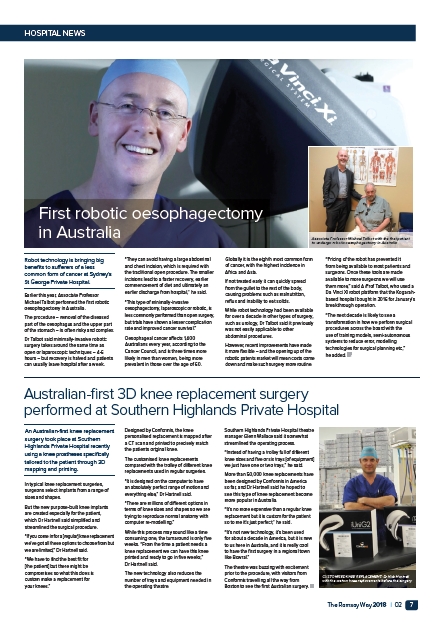
Australian-first 3D knee replacement surgery
performed at Southern Highlands Private Hospital
The Ramsay Way 2018 | 02 7
Robot technology is bringing big
benefits to sufferers of a less
common form of cancer at Sydney’s
St George Private Hospital.
Earlier this year, Associate Professor
Michael Talbot performed the first robotic
oesophagectomy in Australia.
The procedure – removal of the diseased
part of the oesophagus and the upper part
of the stomach – is often risky and complex.
Dr Talbot said minimally-invasive robotic
surgery takes around the same time as
open or laparoscopic techniques – 4-6
hours – but recovery is halved and patients
can usually leave hospital after a week.
“They can avoid having a large abdominal
and chest incision, which is required with
the traditional open procedure. The smaller
incisions lead to a faster recovery, earlier
commencement of diet and ultimately an
earlier discharge from hospital,” he said.
“This type of minimally-invasive
oesophagectomy, laparoscopic or robotic, is
less commonly performed than open surgery,
but trials have shown a lesser complication
rate and improved cancer survival.”
Oesophageal cancer affects 1,400
Australians every year, according to the
Cancer Council, and is three times more
likely in men than women, being more
prevalent in those over the age of 60.
Globally it is the eighth most common form
of cancer, with the highest incidence in
Africa and Asia.
If not treated early it can quickly spread
from the gullet to the rest of the body,
causing problems such as malnutrition,
reflux and inability to eat solids.
While robot technology had been available
for over a decade in other types of surgery,
such as urology, Dr Talbot said it previously
was not easily applicable to other
abdominal procedures.
However, recent improvements have made
it more flexible – and the opening up of the
robotic patents market will mean costs come
down and make such surgery more routine.
“Pricing of the robot has prevented it
from being available to most patients and
surgeons. Once these tools are made
available to more surgeons we will use
them more,” said A/Prof Talbot, who used a
Da Vinci XI robot platform that the Kogarahbased
hospital bought in 2016 for January’s
breakthrough operation.
“The next decade is likely to see a
transformation in how we perform surgical
procedures across the board with the
use of training models, semi-autonomous
systems to reduce error, modelling
technologies for surgical planning etc,”
he added.
HOSPITAL NEWS
First robotic oesophagectomy
in Australia
Associate Professor Michael Talbot with the first patient
to undergo robotic oesophagectomy in Australia
An Australian-first knee replacement
surgery took place at Southern
Highlands Private Hospital recently
using a knee prostheses specifically
tailored to the patient through 3D
mapping and printing.
In typical knee replacement surgeries,
surgeons select implants from a range of
sizes and shapes.
But the new purpose-built knee implants
are created especially for the patient,
which Dr Hartnell said simplified and
streamlined the surgical procedure.
“If you come in for a regular knee replacement
we’ve got all these options to choose from but
we are limited,” Dr Hartnell said.
“We have to find the best fit for
the patient but there might be
compromises so what this does is
custom make a replacement for
your knees.”
Designed by Conformis, the knee
personalised replacement is mapped after
a CT scan and printed to precisely match
the patients original knee.
The customised knee replacements
compared with the trolley of different knee
replacements used in regular surgeries.
“It is designed on the computer to have
an absolutely perfect range of motion and
everything else,” Dr Hartnell said.
“There are millions of different options in
terms of knee sizes and shapes so we are
trying to reproduce normal anatomy with
computer re-modelling.”
While this process may sound like a time
consuming one, the turnaround is only five
weeks. “From the time a patient needs a
knee replacement we can have this knee
printed and ready to go in five weeks,”
Dr Hartnell said.
The new technology also reduces the
number of trays and equipment needed in
the operating theatre.
Southern Highlands Private Hospital theatre
manager Glenn Wallace said it somewhat
streamlined the operating process.
“Instead of having a trolley full of different
knee sizes and five or six trays of equipment
we just have one or two trays,” he said.
More than 50,000 knee replacements have
been designed by Conformis in America
so far, and Dr Hartnell said he hoped to
see this type of knee replacement become
more popular in Australia.
“It’s no more expensive than a regular knee
replacement but it is custom for the patient
so to me it’s just perfect,” he said.
“It’s not new technology, it’s been used
for about a decade in America, but it is new
to us here in Australia, and it is really cool
to have the first surgery in a regional town
like Bowral.”
The theatre was buzzing with excitement
prior to the procedure, with visitors from
Conformis travelling all the way from
Boston to see the first Australian surgery.
CUSTOMISED KNEE REPLACEMENT: Dr Nick Hartnell
with the custom knee replacements before the surgery